Interview with Kevin Staniec, Paper Farms Publisher
By Eveline Morel | March 12th, 2013 | Category: Interviews, L.A. Art & Culture | 2 comments
Questions by Eveline Morel
Responses by Kevin Staneic
How did you decide to start Paper Farms? Did you have any previous experience in publishing? If not, how did this all come about?
I have been in the publishing industry for over 10 years. It started with ISM. We had just graduated college and were searching for something to inspire us. What began as a concept with simple business cards developed into an internationally recognized movement and arts non-profit, welcoming all to share their creative ideas, giving a voice to many who shared a passion for art with no avenue to explore their talent.Our mission is to support collaborative creativity by producing international art experiments and providing free public programs. One of our more successful projects was a tribute to instant film and the now-expired Polaroid 600 Series. With a viral online movement building, word spread—photography submissions arrived from around the world, like-minded organizations inquired about partnered efforts, and some of Polaroid’s most visible proponents offered their advocacy. The project had blossomed into a cause, and a rally of admirers assembled to support the charge. Its sentiment enticed the plight of romantics everywhere: those that cling to vinyl despite iTunes, lug paperbacks around in spite of Kindles, and fawn over hand-written letters regardless of E-mail. The exhibition welcomed an audience of over 3,000 people, some of whom flew in from across the country, to participate in their project. The final book that documented the experiment was titled STILL DEVELOPING: A STORY OF INSTANT GRATIFICATION.
Paper Farms was an idea that was brewing for many years, and it was the perfect time to launch the new company during our 10-year anniversary for ISM. Now, Paper Farms handles 4 imprints: Black Hill Press, ISM Community, Paper Ink Glue, and Treehouse Bandits.
These days, with everything moving towards digital, isn’t publishing books in print a bit of a wasted effort? Then again, some of us still like the feel of paper, and the rustle of the pages as we turn them . . . Are you also publishing the books in digital format? Which ones? How do the sales compare for digital vs. paper? What about Kindle vs. iTunes? Does digital publishing make it easier for artists to get their work out there?
The most exciting thing about bookmaking today is that we are allowed to experiment. There are so many options and alternatives to every aspect of publishing. Our goal is to try everything and hopefully create new procedures in the process. We are currently using Amazon, Kindle, Nook, iTunes, as well as niche distribution. We use our numbers and the demand for specific titles to dictate the direction of each product. Each platform is different and contains its own vocabulary with its own challenges; however, we are willing to learn and catalogue our experiences. After a year of pushing and sharing, we’ll evaluate our numbers and decide from there what avenues have been more productive and beneficial to the growth of our books. Personally, I love the printed form. I have walls covered with books and paintings, and it would be difficult for me to see my house any other way.
How did you end up picking these three authors? Did living in LA affect your choice at all (i.e., LA-based writers)?
One key difference with Black Hill Press is that every Contemporary American Novella is released within a collection of three. Each series is titled after the artist that illustrates the covers for the three books. The first group of novellas was the Mark Smith Collection, which includes ANOTHER NAME FOR AUTUMN by Corrie Greathouse, THE BIG DROP: HOMECOMING by Ryan Gattis, and THE FRONTMAN by Jon Frechette. Each book in each set is a complete contrast from one another. Our hope is to challenge readers to jump genres and read out of their normal comfort zone. Ironically, for the first three authors, they all live in Los Angeles. This was not intentional, and it developed organically. Jon had completed the script and was in pre-production to film the story, while also writing the concept as a novella. Ryan, coming off the success of KUNG FU HIGH SCHOOL, was experimenting with genres while living in downtown and felt an overwhelming inspiration to follow the many great noir writers who had used downtown as their setting. Corrie, who lives on the west side of Los Angeles, had been writing and performing a lot of poetry around Southern California, and her voice was gaining a lot of attention. I challenged her to try writing a novella, and she managed to keep her unique prose sensibilities while also stringing together an incredible character at odds with love and relationships.
From your vantage point, how do you see the literary landscape of LA? Do you see more literary talent now than in the last decade, or less?
I am definitely drawn to the voice of Southern California, especially stories that involve Los Angeles as a character. Some of my favorite stories by John Fante, Nathanael West, F. Scott Fitzgerald, and Charles Bukowski are, in my opinion, love letters to Los Angeles. My only problem with the literary landscape of LA is the lack of literary sanctuaries. With the closing of many independent bookstores, followed by Borders, and a thinning Barnes & Noble, it is difficult to grow a community of readers and writers when we are spread so far from one another across this vast desert of creativity. We need a house where we can all meet.
5. Is Hollywood gobbling up the best of the talent, or do you see a resurgence of fiction writing? Is this a movement (away from screen-writing and back to books) or more of an exception?
I like to think that most writers write because they love the pairing of words. For me, it doesn’t matter much which format you are using as long as you share your stories. I enjoy reading and writing poetry, short stories, novellas, novels, fiction, non-fiction, scripts, and plays. Each form has its highlights; but in the end, no matter what, I tend to always fall in love with character.
Why novellas, as opposed to full-blown novels? Will you continue to focus on novellas only, in the future?
Black Hill Press will only be publishing novellas. Our company is dedicated to distinctive, mid-length fiction that is often overlooked as a literary genre. Some of my favorite books are novellas—OLD MAN AND THE SEA by Ernest Hemingway, THE POSTMAN ALWAYS RINGS TWICE by James M. Cain, and HOUSE ON MANGO STREET by Sandra Cisneros. This artfully crafted form is perfect for me. I have problems focusing on longer fiction and feel unfulfilled with short stories. I want a story that has a simple cast of strong characters, where I can emotionally invest my time with an experience rather than a journey. The novella is the equivalent in length and time to your average movie or album. I compare it to a long overdue lunch with a friend where you finally have the opportunity to catch up on all those amazing moments you missed. I love the fact I can finish a book during a day off work or a weekend vacation. I also love the fact that the novella is an easy share and never intimidating. I have recommended BAD NATURE or WITH ELVIS IN MEXICO by Javier Marías to many friends, and it’s a quick read that packs a hard punch.
Do you think the future of the novel is the novella—more compact, faster to read, shorter, etc.?
I would never want the novella to replace short stories or novels. But it is important to recognize this artfully crafted form. Bookstores, libraries, and university stores should have a section dedicated to novellas. I feel most books are improperly categorized and it is our responsibility to celebrate the novella for what it is and not try to disguise it as something it is not.
Do you have any favorite writers that have inspired you and continue to do so?
Definitely the authors I just mentioned. I would also love to add to that list: Jack Kerouac, John Steinbeck, Ray Bradbury, George Orwell, and J.D. Salinger.
Any closing statement and/or comments?
Support your independent publishers, bookstores, and libraries. Keep a journal and never stop writing. When you read a good book, recommend it, and share it. Attend book readings and join book clubs. Oh, and visit paperfarms.com.










[…] Literary Los Angeles […]
[…] Agenda Magazine interviewed Kevin Staniec. He talked about Paper Farms, Black Hill Press, and ISM / agendamag.com Theodor […]